| |||||||||||||
| |||||||||||||


|
|
|||
|
Languages of AlsaceAlthough Alsace was a German dialect-speaking region for most of its history, today nearly all Alsatians speak French. About 25% of the local population is still fluent in the Alsatian language (as a mother tongue) or in German (as a second language). Alsatian DialectAlsatian (Elsässerditsch; French: Alsacien; German: Elsässisch or Elsässerdeutsch) is a Low Alemannic German dialect spoken in most of Alsace, a region which has passed between French and German control many times. Not readily intelligible to speakers of standard German, it is closely related to other nearby Alemannic dialects, such as Swiss German, Swabian, and Badisch. It is often confused with Lorraine Franconian, a more distantly related Franconian dialect spoken in the far north-east of Alsace and in neighboring Lorraine. Many speakers of Alsatian write in standard German. Street names in Alsace may use Alsatian spellings; they were formerly displayed only in French but are now bilingual in some places, especially Strasbourg. Status of Alsatian in FranceThe constitution of the Fifth Republic states that French alone is the official language of the Republic. However, Alsatian – along with other regional languages – is recognized by the French government in the official list of languages of France. A 1999 INSEE survey counted 548,000 adult speakers of Alsatian in France, making it the second most-spoken regional language in the country (after Occitan). Like all regional languages in France, however, the transmission of Alsatian is on the decline. While 39% of the adult population of Alsace can converse in Alsatian, only one in four children speaks it, and only one in ten children uses it regularly.
Editing, translation, and portions written by Ian C. Mills © 1999- – All Rights Reserved. Sources: Wikipedia, the free encyclopedia. Ethnologue, Languages of the World. L'alsacien, deuxième langue régionale de France, a Dec. 2002 report (6-pg. PDF) from INSEE, Institut National de la Statistique et des Études Économiques. Images: Street sign in French and Alsatian, from Wikimedia Commons. Rue des Fleurs – Bluamagass (street sign), Egon Bömsch (photographer), from Age Fotostock. Rue de la Monnaie – Menzgassla (street sign), photographer unknown, from Friends of the Segovia Mint Association. All Rights Reserved. Traditional Costumes of Alsace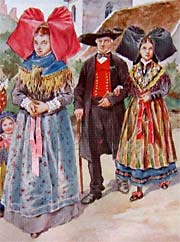
Traditional Alsatian garb worn at end of 19th, beginning of 20th century. Watercolor by Paul-Adolphe Kauffmann (1849-1940), French illustrator, of Belfort. (click to enlarge) A traditional symbol of the region, the famous Alsatian headdress was abandoned after 1945. Today, this can only be admired during certain cultural and tourist events. Varying widely from one part of Alsace to another, the traditional costumes reflected the social standing and faith of their wearers. Consequently, Protestant women in the north would wear the colors of their choosing, whereas Catholics from Kochersberg (to the northwest of Strasbourg) wore only ruby red. Some women would decorate the hems of their skirts with velvet ribbons. Others, particularly in the south, would wear printed cotton clothing, often made of silk for special occasions with paisley patterned designs. The aprons, worn everywhere throughout Alsace, were plain white. However, on Sundays it was not uncommon to see silk or satin aprons decorated with embroidery, and worn over skirts or dresses. Headdresses were extremely diverse, with an increasing trend towards the use of ribbons from 1840 onwards. Always black for Protestants, the headdresses were often colourful and decorated with patterns for the Catholics. These features may come as a surprise, as illustrators have often portrayed an inaccurate image of traditional Alsatian costumes. When Alsace once again became part of France, the "illustrator's costume" was adopted by the entire region, replacing the vast variety of traditional clothing which once existed.
Editing, translation, and portions written by Ian C. Mills © 1999- – All Rights Reserved. Source: Comité Régional du Tourisme d'Alsace, 68000 Colmar (tel: 03-89-24-73-50). Images: Traditional Alsatian garb, (cropped from original) watercolor by Paul-Adolphe Kauffmann, from Alsace Voyages. All Rights Reserved. Cuisine of Alsace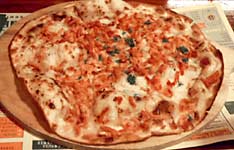
Flamekeusche (tarte flambée) Alsatian cuisine does not shy away from calories or carbohydrates; it dishes up rich, robust, rib-sticking recipes in generous portions, with no regard for anyone's waistline. While many of the recipes are influenced by Germanic culinary traditions, the flair with which they are cooked is uniquely French. Alsatian food is synonymous with conviviality. Traditional dishes are marked by the use of pork in various forms, including baeckeoffe, tarte flambée (pictured at right), choucroute, and fleischnacka. Southern Alsace, also called the Sundgau, is characterized by carpe frite (fried carp). 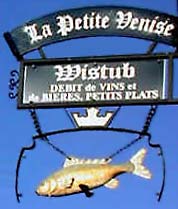
La Petite Venise – a wistub (wine bar) in Colmar. The sign promotes their plate special: carpe frite.
The gastronomic symbol of the region is undoubtedly sauerkraut. The word "sauerkraut" in Alsatian has the form "sûrkrût (saurkraut)", which means "sour cabbage" as its German equivalent. This word was included into the French language as choucroute. To make it, the cabbage is finely shredded, layered with salt and juniper and left to ferment in wooden barrels. Sauerkraut can be served with poultry, pork, sausage or even fish. Traditionally it is served with pork, Strasbourg sausage or frankfurters, bacon, smoked pork or smoked Morteau or Montbéliard sausages or a selection of pork products. Served alongside are often roasted or steamed potatoes or dumplings. 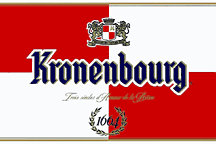
Kronenbourg "1664" beer label The festivities of the year's end involve the production of a great variety of biscuits and small cakes called bredalas as well as pain d'épices (gingerbread), especially from Gertwiller, which are given to children starting on Saint Nicholas Day. Alsace is the main beer-producing region of France, thanks primarily to brasseries (breweries) in and near Strasbourg. These include those of Kronenbourg (Strasbourg), Fischer (produced by Heineken Entreprise, Schiltigheim), Heineken International, Météor (Hochfelden), Kasteel Cru (Brasserie Licorne, Saverne) and Kanterbräu (Strasbourg). Hops are grown in Kochersberg and in northern Alsace. Schnapps is also traditionally made in Alsace, but it is in decline because home distillers are becoming less common and the consumption of traditional, strong, alcoholic beverages is decreasing. 
Réa fruit juice, made by Les Vergers d'Alsace Alsace is also an important wine-producing region. Vins d'Alsace (Alsatian wines) are mostly white and display a strong Germanic influence. Alsace produces some of the world's most notable dry Rieslings and is the only wine region in France to produce mostly varietal wines identified by the names of the grapes used (wine from Burgundy is also mainly varietal, but not normally identified as such), typically from grapes also used in Germany. The most notable example is Gewurztraminer. Additionally, Alsace is known for its fruit juices and mineral waters. The largest juice supplier, Les Vergers d'Alsace (trans.: "Orchards of Alsace"), produces 300 million bottles per year of apple, grape, prune, raspberry and other juices at its plant in Sarre-Union, Bas-Rhin. Cidou (Mietesheim), Junatur (Dossenheim-sur-Zinsel), Ouendmor (Strasbourg), Rothgerber (Traenheim), and Sautter (Sessenheim) are the other notable juice suppliers in Alsace. 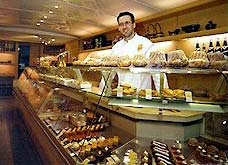
Thierry Mulhaupt behind the pastry counter Our RecommendationsThierry Mulhaupt - Patisserie (since 1991)
Editing, translation, and portions written by Ian C. Mills © 1999- – All Rights Reserved. Sources: Wikipedia, the free encyclopedia. Strasbourg: the best of several worlds, by Ester Laushway, ©1995 Delegation of the European Commission. Edible France, A Traveler's Guide, by Glynn Christian (Interlink Books). Images: Tarte flambée, from Wikimedia Commons. La Petite Venise Wistub sign, from Travel Tales Spring Fling, ©2004 Terry & Sherrie Thorne. Kronenbourg 1664 beer label, from Corey and Nate's BeerLabels.com. Réa fruit juice container, from Eckes Granini France. Thierry Mulhaupt behind the pastry counter, from Thierry Mulhaupt. All Rights Reserved. NEXT PAGE » Departments: Bas-Rhin, Haut-Rhin, and Tourism Offices |
||

|
||||||||||